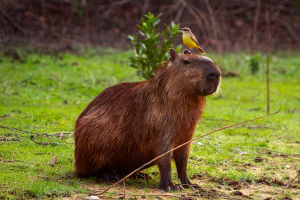There's a certain kind of animal video that always seems to go viral. No dramatic action. No tricks. Just a serene, oversized rodent calmly soaking in a hot spring or letting ducks nap on its back.
That animal is the capybara—often called the chillest creature on Earth. But why do humans feel such a strong pull toward this unlikely internet icon? It's not just the cuteness. Capybaras are teaching us something surprising about emotional intelligence, peaceful coexistence, and what it means to just… be.
What Exactly Is a Capybara?
Capybaras are the world's largest rodents. Native to South America, they live in swampy forests and savannas near water sources. Adults can weigh up to 145 pounds (65.8 kilograms) and reach about 4 feet (1.22 meter) long—but despite their size, they're gentle herbivores who graze on grass, aquatic plants, and fruit.
They have webbed feet, excellent swimming skills, and one highly recognizable feature: their unbothered facial expression, which has become a meme in itself.
The Science Behind Their Calmness
You might assume their mellow vibe is just a quirk, but there's biology at play.
1. Social wiring with good behavior
Capybaras are naturally social animals. They live in large groups of 10–30 members and communicate with subtle sounds: purring, clicking, even whistling. However, unlike other herd animals, they have a good behavior. There's no alpha biting, chasing, or loud dominance behavior.
According to Dr. Eleanor Vance, a specialist in rodent social behavior: "Capybaras are highly social creatures, typically forming groups of 10–30 individuals. Their communication relies on subtle vocalizations like purring, clicking, and whistling. Notably, unlike many other herd species, capybaras exhibit minimal dominance displays."
2. Built for cohabitation
Capybaras are one of the few mammals that seem universally liked by other animals. They're often seen sharing space with monkeys, ducks, turtles, and even predators—who, for some reason, don't always view them as food.
Wildlife biologists believe this tolerance is tied to both their passive nature and their scent-marking habits, which broadcast their calm presence early on.
Why They Thrive in Zoos and Animal Parks
It's no accident that capybaras have become the unexpected stars of petting zoos, farm visits, and animal therapy events.
1. They don't startle easily.
Many petting zoo animals, like goats or rabbits, can get nervous around loud children or crowds. Capybaras tend to stay relaxed—even when being gently petted by visitors. This creates a low-stress environment for both the animal and the people.
2. They interact on their own terms.
Unlike dogs or cats, capybaras don't force interaction. They'll sit near you. They might let you brush them. But they're not clingy or demanding—which makes them a perfect animal for mindful observation rather than active play.
3. They're surprisingly clean.
Capybaras spend hours grooming themselves and each other. This makes them more manageable in controlled environments, since they don't give off strong odors or create chaotic messes.
Capybaras and Human Emotion: A Deeper Connection
So why do people seem so emotionally moved by capybaras? The answer might lie in a concept called emotional mirroring.
When we watch a calm animal exist peacefully—especially one as large and slow-moving as a capybara—it taps into our own parasympathetic nervous system. This is the system responsible for slowing the heart rate, lowering blood pressure, and promoting a sense of safety.
Therapists and educators have even begun to explore capybaras in animal-assisted therapy programs, especially for individuals with anxiety, PTSD, or sensory sensitivities.
They're Not Meant to Be House Pets
While many people fantasize about owning a capybara after seeing them online, experts urge caution.
Capybaras are semi-aquatic animals, which means they need access to clean, deep water to swim in every day. A kiddie pool isn't enough—they require space, filtration systems, and careful maintenance.
They're also social, and keeping just one can lead to depression. In most cases, you'd need to keep at least two—plus comply with local exotic animal laws.
Veterinarian Dr. Emily Sorensen notes, "People often underestimate the environmental needs of capybaras. ' They're highly sensitive animals with specific needs."
In short: enjoy them at reputable farms, sanctuaries, or animal parks—but think twice before considering one as a backyard pet.
Where Can You See Capybaras in the U.S.?
If you're curious about experiencing a capybara encounter, here are a few great places in the U.S. that offer ethical, hands-on experiences:
1. Animal Edventures, Florida
Offers small-group capybara meet-and-greets where visitors can feed, pet, and even sit with capybaras in a shaded enclosure. Entry: around $25–35 per person.
2. Texas Capybara Encounter, Dripping Springs, TX
Private farm experience where you can learn capybara care, swim with them in a pond, and interact directly. Reservations required; prices range from $40–60.
3. Wildlife World Zoo, Arizona
This large facility houses capybaras in a walk-through habitat where you can observe them lounging and swimming in groups. Admission: $47 for adults.
More Than a Meme
Capybaras aren't popular just because they're cute. They represent something deeper: an emotional ideal we crave in an overstimulated world. Calm. Softness. Mutual respect.
So next time you see a photo of a capybara chilling with a bird on its head, know this—behind the meme is a living animal that reminds us how to move more slowly, breathe more fully, and live more gently.
Have you ever met a capybara in person? Would you be curious to sit beside one in total silence for a while? You might come away feeling just a little more peaceful.


